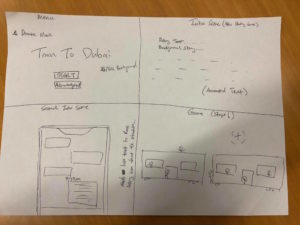I decided to use one of my previous processing sketches and incorporate serial communication into it. The processing sketch I used was my self-portrait. I decided that I wanted to create something that could be used in a party. When the light dims down, the kaleidoscopic-like portrait would fade onto the wall. The project is hyperlinked here. The code I used is incorporated below, I used the handshake technique between processing and Arduino:
Self-portrait:
void setup(){
size(480,640); //w,h
frameRate(5);
//fill(255,192,203);
//ellipse(240,400,100,100);
}
float radius;
void draw(){
background(0, 0, 0);
fill(0);
stroke(255);
ellipse(240,325,730,800);
stroke(255);
ellipse(240,325,630,700);
stroke(255);
ellipse(240,325,530,600);
stroke(255);
ellipse(240,325,430,500);
stroke(255);
ellipse(240,325,330,400);
stroke(255);
ellipse(240,325,230,300);
fill(255);
stroke(0);
ellipse(240,200, 150, 190);
fill(255);
ellipse(115,350, 50, 80);
fill(255);
ellipse(365,350, 50, 80);
fill(0);
ellipse(100,370,5,5);
fill(0);
ellipse(100,370,5,5);
fill(0);
ellipse(379,370,5,5);
fill(random(0, 204), random(0, 255), random(0, 255));
ellipse(240,330,275,350); //x,y,w,h
fill(255);
ellipse(240,360,275,350); //x,y,w,h
fill(random(0, 255), random(0, 255), random(0, 255));
ellipse(300,340,75,75); //glasses 1
fill(random(0, 255), random(0, 255), random(0, 255));
ellipse(180,340,75,75); //glasses 2
line(216, 340, 264, 340); //middle portion of glasses
line(104, 340, 141, 340); //side portion of glasses
line(336, 340, 375, 340); //side portion of glasses
fill(255);
stroke(0);
arc(240, 410, 50, 35, PI, PI+QUARTER_PI);
arc(225, 410, 20, 20, HALF_PI, PI);
arc(270, 450, 170, 50, HALF_PI, PI);
arc(170, 440, 50, 35, PI, PI+QUARTER_PI);
arc(260, 485, 100, 10, HALF_PI, PI);
arc(260, 470, 50, 30, PI+QUARTER_PI, TWO_PI);
arc(210, 460, 60, 30, PI+QUARTER_PI, TWO_PI);
fill(0);
ellipse(225, 410, 3, 3);
//fill(0);
//stroke(255);
//ellipse(240,150,115,130);
stroke(0);
line(257, 410, 255, 380);
}
Arduino:
bool ledState=LOW;
int knobpin = A1;
int led=3;
void setup() {
Serial.begin(9600);
pinMode(led, OUTPUT);
Serial.write(0);
// put your setup code here, to run once:
}
void loop() {
if(Serial.available()>0){ //if arduino receving something
int inByte=Serial.read();//when you read something off buffer, it goes off the buffer
int readvalue=analogRead(knobpin); //knob
int writevalue = map(readvalue,0,1024,0,255);
Serial.write(writevalue);
analogWrite(led,writevalue);
delay(1);
}
I wanted to add more elements to this project such as adding music using an mp3 shield once the processing sketch is revealed. I also wanted to add a flex sensor that would simulate a wristband on people. Every time it moved, making the assumption that it moved because they people were dancing, my glasses would start changing color (as it does already). I have had tremendous difficulty coding this, and because I got slightly injured I didn’t have the time to go back and work on this aspect. If I am able to complete my weekly project for this week on time, I really want to spend some time enhancing this project.

